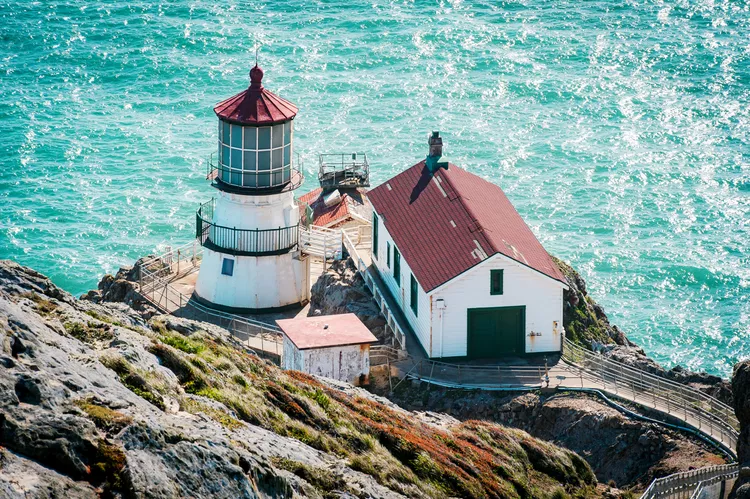Summary of Point Reyes Lighthouse
The Point Reyes Lighthouse is one of the most dramatic lighthouses in California. Located at the westernmost tip of a headland extending 10 miles into the Pacific Ocean, it serves as a vital warning light for sailors navigating through one of the windiest and foggiest spots in North America.
Overview of Point Reyes Lighthouse
Positioned at a breathtaking location, reaching the lighthouse involves descending a steep staircase with over 300 steps, akin to climbing down a three-story building. The vantage point from the top of the staircase offers stunning views, though the descent itself can be dizzying.
What to Do While You’re There
The Lighthouse Visitor Center, located on the west side of the Point Reyes peninsula, offers a glimpse into the lighthouse’s construction and a rich history of lives saved throughout its 125-year existence. Visitors can see the original clockworks from 1867 and the first-order Fresnel lens during specific hours, weather permitting.
During selected summer dates, the Illuminating the Light program allows visitors to engage further with the history of this remarkable site.
When making the trip to the lighthouse from the visitor center, it’s crucial to be aware of the challenging staircase that leads down. Given that Point Reyes is known for its fog, visitors should pack warm clothing, even if the weather appears mild inland.
From December through early April, the park becomes a hotspot for viewing elephant seals and observing whale migration. Due to the high volume of visitors during this time, park rangers may close Sir Francis Drake Blvd. past South Beach on weekends. However, shuttle buses are available to transport visitors to the lighthouse from the Drake’s Beach parking lot, with tickets sold at the visitor center.
Capturing photos of the lighthouse can be disheartening if you are expecting sunny skies, as Point Reyes is the foggiest location in North America. A quick online image search will reveal that clear skies are rarely seen here.
A Fascinating History
Constructed in 1870, the Point Reyes Lighthouse features a 16-sided tower standing 37 feet tall, identical to the Cape Mendocino Light, which is not open to the public. The original Fresnel lens and clockwork system arrived from France via a steamer ship that navigated around South America before being transported to the headlands on ox-drawn carts.
Initially staffed by a head keeper and three assistants, duties included winding the clockwork mechanism every two hours, which was essential for maintaining the lighthouse’s light rotation. The lighthouse was electrified in 1938, but before this innovation, keepers had to trim oil-burning wicks to ensure the light remained bright.
Despite diligent maintenance, sailors often struggled to see the light through fog. In 1881, a steam siren was introduced and later replaced by a steam whistle in 1890. By 1915, an air diaphone was installed, capable of being heard up to five miles away.
The harsh weather conditions at Point Reyes often left lightkeepers with a challenging existence. Edwin G. Chamberlain, one lightkeeper, once wrote in the logbook: “Better dwell in the midst of alarms than reign in this horrible place.” Nonetheless, some keepers endured, such as Paulus Nilsson, who worked at the lighthouse from 1897 until 1921.
The U.S. Coast Guard decommissioned the lighthouse in 1975, replacing it with an automated light and transferring operations to the National Park Service. To gain further insight into life at the lighthouse, reading the keeper’s logs from 1888 provides fascinating details about their daily tasks and challenges.
Visitor Information
Located within Point Reyes National Park, the lighthouse is easily accessible for those looking to explore nearby sights, including Limantour Beach.
Keep in mind that the stairs to the lighthouse close whenever wind speeds exceed 40 mph, although views of the lighthouse from the top of the staircase remain accessible year-round. Visitors should check the Point Reyes website for the most current visitor center hours as they may vary.
Getting to the lighthouse involves a scenic drive that makes the 36-mile trip from San Francisco feel much longer. Travelers can take US 101 north of San Francisco, then head west on Sir Francis Drake, or take California Hwy 1 north through Stinson Beach to Olema. Once you reach the entrance to Point Reyes National Seashore, expect approximately an hour’s drive to the lighthouse.
For those wishing to explore further in the Point Reyes area, there are countless resources available to assist in planning an extended visit.





